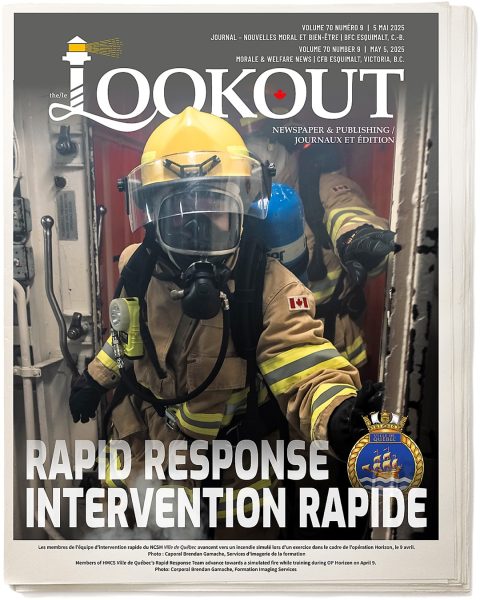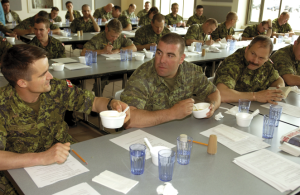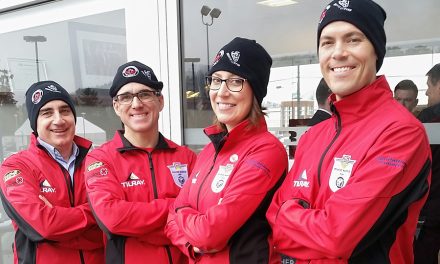Marching ammo.
Soldier fuel.
Combat rations.
Whichever term is used, developing new combat rations that will be well accepted by Canadian Armed Forces (CAF) members is serious business.
Ann Delaney and Megan Buchanan, Combat Rations Specialists with the National Combat Rations Program, put their food science degrees to good use by helping create new and healthier portable meals for the CAF.
They work with registered dietitian Hilda-Anne Troupe and other team members at the Directorate of Food Services in Gatineau, Quebec, to formulate rations that will provide optimal nutrition for optimal performance in any operational situation.
Each three-year research and development cycle aims to create three to four new recipes.
The process begins with an analysis of food trends, soldiers’ feedback, NATO standards, and current nutritional research, and then continues with field trials of the newly created sample meals at the brigade level before they are approved for production and delivery.
Also called Individual Meal Packs or IMPs, they contain between 1,200 and 1,400 calories per meal and come in a variety of carefully-developed menu options. Traditionally, a paper questionnaire was inserted in each ration pack, numbering about one million a year.
Unfortunately, only a relatively small number were being returned annually, since filling out a questionnaire on the battlefield or during training was inconvenient, to say the least.
To remedy this, the combat rations team is now taking advantage of social media.
The program’s Facebook page at www.facebook.com/pages/Canadian-Combat-Rations-Rations-de-Combat-Canadiennes/213893152120758 has an online version of the questionnaire.
Eventually users will be able to access the page for nutritional information, product development and to post questions.
As of spring 2015, the outer packaging of new IMPs will display a Quick Reference Code, or QRC that can be scanned by smartphones to access the combat rations Facebook page.
There are 21 meals available, broken up into two categories of seven breakfasts and 14 “day meals” that can be used for either lunch or supper.
In addition to the main meal, each IMP contains assorted basics such as powdered coffee, protein and sports drink mixes, energy bars, trail mix, peanut butter, cereal, condiments, candy, chocolate, gum, a plastic spoon, a wet towelette and matches.
To meet various member requirements, the vegetarian options are formulated to meet kosher and halal requirements as well.
For the general population, there are tried-and-true comfort foods like shepherd’s pie and spaghetti with meatballs.
Hamburger and smoked meat meals debuted in 2014.
Some are more leading-edge, such as the most recent additions to be found in soldier backpacks in the spring of 2015: pulled pork and poutine.
The IMPs are fully cooked and ready to eat straight from the packaging, but most are improved by heating when conditions and time permit.
IMPs provide adequate nutrition when fresh food is not available to the troops because of conditions during exercises and operations.
According to studies, nutrition has an effect on achieving optimal cognitive, physical and psychosocial performance.
Troops are often subject to physical and environmental extremes; therefore nutrition plays a key role in resilience (the ability to fight the fight), recovery of nutritional status after military activities (the ability to fight another day) and on the soldier’s long-term wellness, injury prevention and quality of sleep and mood.
“Nutrition is complex and requires sound evidence based on scientific data to support the requirements of the soldier,” said Troupe.
“The National Combat Rations team and the Directorate of Food Services consider current research by other nations in the area of military feeding when looking at new products for the IMPs.”
She notes that the directorate is currently working with Defence Research and Development Canada to determine CAF soldiers’ energy expenditure versus intake and the acceptance level of current IMPs.
Information obtained from this research will be considered in future combat rations development.
The technology used to package the food provides a number of challenges, according to Delaney, who has 13 years of experience in her role.
The processing technology was invented in the 1970s by the United States Army in partnership with industry.
It produces a product comparable to canned food – without the can.
This technology uses less energy and fewer resources than metal or glass packaging and is lighter to carry.
The packaging used is called a “retort pouch” which is similar to a can but is lighter and more flexible.
The food is inserted into the pouch, sealed, then heated under pressure to cook and sterilize the food.
According to Delaney, the temperatures required for processing retort pouches are lower than for a can, which means more of the sensory and nutritional qualities of the food are retained.
She notes that some popular meals do not lend themselves well to this type of processing, so the team works to get as close as possible under the circumstances.
In creating a poutine IMP, the team basically deconstructed the ingredients and adapted them to the technology.
“We couldn’t make fries, so we have cooked potatoes with gravy, cheese and big chunks of cooked chicken to add some protein,” she said.
“When we tested it in the field, they liked it very much.” Pizza is another tricky one, so they created a pizza-flavoured pasta meal with peppers and sausage instead, to good reviews.
Not everything is a hit, however.
“We have had surprises when we thought a meal was very promising, but the people didn’t like it,” said Delaney.
“Every second year, we go to brigades in Valcartier, Petawawa and Edmonton to test the new menus with about 60 people from each brigade,” she said.
“They are the ones who will ultimately decide if they will go into the rations.”
Delaney notes that although an IMP’s expiry date is three years from the date it is assembled, it is still safe to eat for quite some time afterward as long as the pouch is not damaged and the IMP has been properly stored.
“Shelf life is related not to food safety but to the sensory quality of the food. We take into account that after three years, the bread may be too dry or the texture and appearance of the fruit may not be as interesting,” she said.
“But because the main components are sterilized, you can open a ration and if the retort pouch is intact, the content is still good to eat because the sterile environment remains.”
Lynn Capuano
Army Public Affairs













